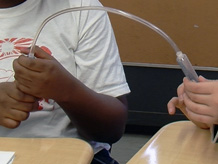Is air matter?
2. Explore air in a closed system
Before you distribute the tubing and syringes, remind students that if air is matter, it has to take up space. A question is:
What positions do students take? Be sure to hear from students with positions on each side of the question. Ask students to make a claim and to provide the evidence or reasoning on which their claim is based.
Give each pair of students two syringes and a 16-inch length of clear plastic tubing, to set up the following system:
- Set the plunger of each syringe at the middle of its barrel (the 6 cc line).
- Push one end of the clear plastic tubing onto the tip of each syringe.
Describe this set-up as a system.
- The 2 syringes, tube, and air.
- Like the 2-bottle system, the connected syringes form a closed system. Nothing can get in or out once the system has been set up.
- The outside of the tubing and syringes.

Have students explore the system. It takes no more than a minute or two for students to explore how the system works. The point is to let them experience a situation in which air clearly takes up space.
- What happens when you push one plunger very slowly while not touching the other plunger?
- What happens when you push one plunger very quickly while not touching the other plunger?
- Do you find evidence that air takes up space?
Collect the syringes while students write a response to the [Does air takes up space?] page in their Science Notebooks.



